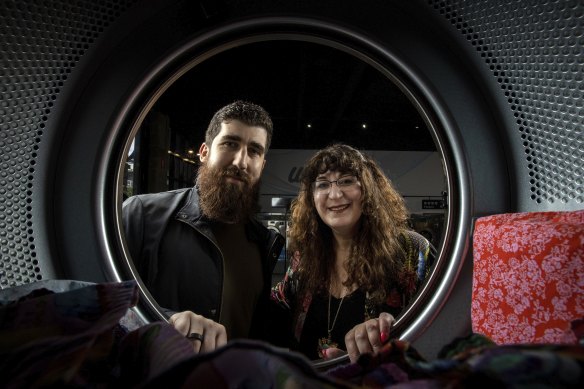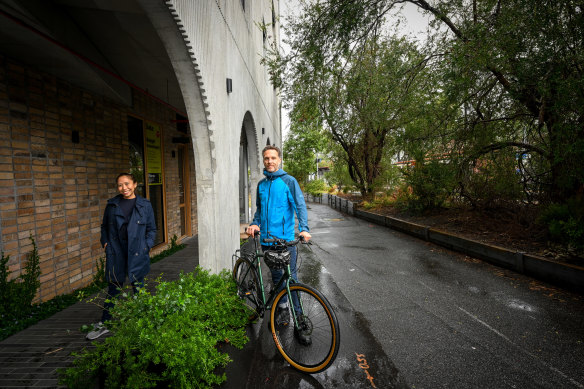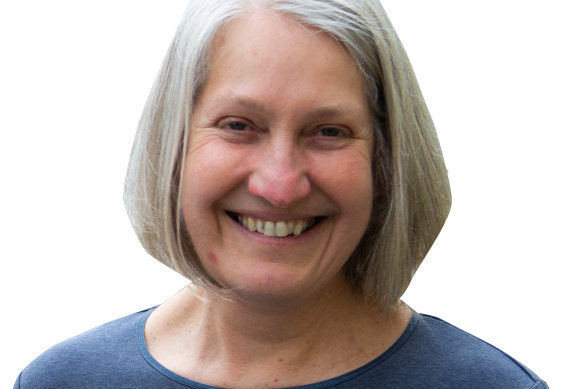This was published 1 year ago
What the ‘laundromat index’ tells us about Brunswick’s heated housing debate
The rapid pace of development in Brunswick is leading to big changes in how people live. It suits the laundry industry, but on some streets the tensions are starting to show.

Sean Mallard and his mother, Enrica Mallard, at their Brunswick East laundromat.Credit: Darrian Traynor
When Sean Mallard was looking to open a laundromat in Brunswick, he did his research. He wrote a computer program that combed the census for streets with high numbers of renters, students and young professionals and a low number of laundromats.
It spat out the perfect address. But as he and mother Enrica Mallard waited for the tick of approval from the building manager on Lygon Street, East Brunswick, three laundromats suddenly popped up in the area.
“It was crazy,” he says. His business, Laundry Plus, is now one of almost 15 in the area serving people he describes as “space poor and time poor”.
Fortunately for him, so many nearby residents fit this description that he is thinking of opening another outlet.
There was a time when Australians did their washing in the home machine and dried it on the Hills Hoist in the backyard. But Brunswick’s laundromat index is one measure of the explosion in medium to high-density living in Melbourne’s inner suburbs in the past decade.
Another measure is the 2021 census. It showed there were nearly 12,000 apartments in Brunswick, almost twice the amount in 2011. Thirty-six per cent of the suburb’s population now live in apartments, compared with the Victorian average of 12 per cent, and another 25 per cent live in townhouses and terrace houses.
Brunswick is not the only inner-Melbourne electorate that has gone through such rapid growth. The City of Yarra has also almost doubled its number of apartments since 2011. It’s what the state government document Plan Melbourne suggests must happen throughout the inner suburbs to accommodate the city’s expanding population.
But now, in the midst of a housing crisis, there is a sense of unease at the pace and style of some growth, and this has led to an emerging rift on one council.
Last month, Merri-bek council rejected the proposed height of a building on Florence Street by Nightingale, a not-for-profit group that many believe is at the forefront of good apartment design.

Nightingale residents Christa Orcullo and Kai Brach.Credit: Eddie Jim
Nightingale wanted to breach the council’s recommended height limit of five storeys and build a seven-storey, 28-apartment development, including three apartments to be transferred to an agency providing affordable rental housing to people on low incomes. There are a number of other developments in the area of seven or eight storeys, but the council reduced the proposal to six levels, which means, according to Nightingale, that the affordable housing component is no longer viable.
“The loss of the social housing component in particular is a really bad outcome for those in the most need of secure housing,” says Nightingale chief executive Dan McKenna.
The alliance of votes on the council that knocked it back is a microcosm of the growing tensions in this high-development area. One former Greens councillor, James Conlon, who quit the party after Lidia Thorpe’s exit in February, joined two Socialists and three other independents to form a majority on the 11-member council to vote it down.
Socialist councillor Sue Bolton said she wanted to crack down on developers “setting their own height limits”. State government rules do not permit councils to impose mandatory height limits, but Bolton said they had consulted the community and agreed five storeys was right in “activity areas”.

Socialist councillor Sue Bolton
Conlon, now an independent, accused developers of using the concept of affordable housing to “blackmail councils into approving developments that breach planning controls”.
Three other independents, including deputy mayor Helen Davidson, are worried about increasing density. Davidson dislikes the fact Nightingale’s multistorey buildings have no car parks because they are close to public transport and bike paths.
“I’m of the view there does need to be parking contained in dwellings, or on-street parking, because people’s life circumstances change – what if they get a job a lot further away from public transport?” Davidson said.
Greens councillor Adam Pulford called the no voters “a kind of unholy alliance” of councillors who “can all agree on what they don’t want, but will never agree on what they want to create. It’s frustrating.” In a housing crisis, he said, the council had a responsibility not to reject new dwellings, particularly affordable ones.
The backlash against some developments in Brunswick has prompted a counter-backlash from the “YIMBY” (Yes In My Backyard, as opposed to Not In My Backyard) movement of people who want to see more housing built.
Part of the problem in this debate is the poor quality of much of the apartment stock built over the past decade. McKenna said what had been built between 2005 and 2015 in the area was “not ageing well”.
According to urban designer Andy Fergus, this was the result of a planning system that was overhauled in the 1990s to kickstart economic growth with little focus on the investment required to ensure livability. In Brunswick, it led to a large number of apartments with little open space or greenery, with growing congestion on the suburb’s narrow streets.
The council is trying to address those concerns with its “park close to home” strategy, which says everyone should live within a 500-metre walk of a park or open space (300 metres in the densest areas).
Mayor Angelica Panopoulos, a Greens member, said Merri-bek had bought up numerous properties across the municipality to turn into parks, which has been funded by developers who pay a levy when their buildings are approved.
But Fergus, who lives in Brunswick, said Melbourne councils had this approach the wrong way round. Instead of buying land after the levy had been raised, councils should determine exactly where the new open space will go and then buy the land well in advance of rezoning, which increases its value. This requires more active state government support, he said, as the levies from developers often grow to a sufficient level only a decade or more after the rezoning occurs. In the interim, land values rocket and councils get less bang for their buck.
He said Merri-bek had recently spent $19 million in a rezoned area to buy private land to build a series of new parks. While necessary, the significant time delay and land value increase meant less open space at a higher cost for dense communities.
“At best estimates, my small neighbourhood has a population of 1800 residents,” Fergus said. “It’s the second or third-densest area in Melbourne, with 250 people to a hectare, and the streets have not seen any investment since the 1970s.
“There has been an immense amount of private investment, and we have not kept pace with the investment in the public environment to make these places livable.”

Many of the customers of Enrica and Sean Mallard’s Brunswick East laundromat are apartment dwellers.Credit: Darrian Traynor
If the laundromat index is any guide, growing urban density will change many of the things we take for granted about life in Australia. That suits laundromat owner Sean Mallard.
A large proportion of his customers are apartment dwellers who do not want soggy washing on racks clogging up their lounge room or tiny balcony, or who have no washing machine or dryer.
With Mallard’s huge machines, “some people manage to squeeze out a family of four in about one hour and 15 minutes”, he says.
“You do that once a week, and you’re done.”
The Morning Edition newsletter is our guide to the day’s most important and interesting stories, analysis and insights. Sign up here.